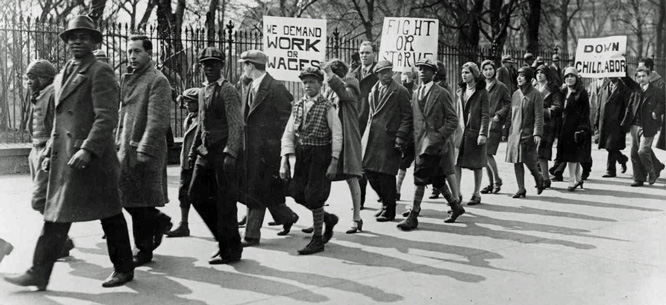Welcome to DU!
The truly grassroots left-of-center political community where regular people, not algorithms, drive the discussions and set the standards.
Join the community:
Create a free account
Support DU (and get rid of ads!):
Become a Star Member
Latest Breaking News
General Discussion
The DU Lounge
All Forums
Issue Forums
Culture Forums
Alliance Forums
Region Forums
Support Forums
Help & Search
Choosing Unemployment: Macroeconomic Policy and American Inequality
from Dissent magazine:
Choosing Unemployment: Macroeconomic Policy and American Inequality
By Colin Gordon - May 1, 2014

[font size="1"]Unemployed march in Washington, D.C., 1930 (Library of Congress via Washington Area Spark/Flickr)[/font]
This series is adapted from Growing Apart: A Political History of American Inequality, a resource developed for the Project on Inequality and the Common Good at the Institute for Policy Studies and inequality.org. It is presented in nine parts. The introduction laid out the basic dimensions of American inequality and examined some of the usual explanatory suspects. The political explanation for American inequality is developed through chapters looking in turn at labor relations, the minimum wage and labor standards, job-based benefits, social policy, taxes, financialization, executive pay, and macroeconomic policy. Previous installments in this series can be found here.
Macroeconomic policies, as the name suggests, take aim at the economy’s overall performance on everything from growth and job rates to price stability. Fiscal policies use taxes and public spending to shape economic growth, demand, and distribution. Monetary policies use interest rates and government securities to control the supply of money and the pace of economic growth. Macroeconomic policies, in other words, speak to both the broad parameters and priorities of public policy—where and how we raise and spend money—and the more immediate management of interest rates and the money supply.
Government revenue and spending policies, in the aggregate, have a substantial impact on economic growth and economic distribution. Federal spending reached about 20 percent of GDP during the Korean War and has been there ever since, dipping a little during good times, rising a little during recessions. Most of this spending—and its distribution—reflects changing policy priorities and demands. Defense spending, for instance, rose into the Vietnam era and then declined, with spikes in the early 1980s and after 9/11. Since then, spending on social programs, especially health care, has taken up most of the slack.
Fiscal policy also reflects the countercyclical logic of public finance: spending as a share of the economy tends to rise during economic downturns and fall during expansions, while tax revenue does the opposite. In this sense, policy commitments, especially on social programs, lean in against fluctuations in the business cycle, protecting the most vulnerable and sustaining demand during hard times. Additional spending commitments (a “stimulus” for example) can enhance these automatic stabilizers. On the other hand, cutbacks elsewhere in government budgets, at either the state or federal level, can blunt them.Choices on the tax side of the ledger, meanwhile, shape the distributional impact of all of this.
.....(snip).....
Macroeconomic Policy and American Inequality
This combination of “foot-on-the-brake” monetary policy and pervasive budgetary anxiety feeds inequality at both ends of the income spectrum. The preoccupation with inflation serves, first and foremost, the nation’s financial powers. For Wall Street, inflation has always been a particular and overriding concern. By calibrating its policies to this concern, the Fed has operated over recent decades as a guardian of the interests and assets of its member banks, not as a steward of economic growth.
This fixation on “sound money,” in turn, has had real and unfortunate consequences for working Americans. And these consequences, including high unemployment and its associated social and economic ills, haven’t been accidental. In practical terms, policymakers have dampened inflation by dampening wages, through both sustained joblessness and a wider range of policies (deregulation, trade liberalization, attacks on collective bargaining, cuts to social programs) designed to erode workers’ bargaining power. Indeed, the architects of this policy have consistently described America’s retreat from full employment as a way of “zapping labor” with concessionary bargaining, trade exposure, and monetary restraint. ......................(more)
The complete piece is at: http://www.dissentmagazine.org/online_articles/choosing-unemployment-macroeconomic-policy-and-american-inequality
InfoView thread info, including edit history
TrashPut this thread in your Trash Can (My DU » Trash Can)
BookmarkAdd this thread to your Bookmarks (My DU » Bookmarks)
1 replies, 840 views
ShareGet links to this post and/or share on social media
AlertAlert this post for a rule violation
PowersThere are no powers you can use on this post
EditCannot edit other people's posts
ReplyReply to this post
EditCannot edit other people's posts
Rec (3)
ReplyReply to this post
1 replies
 = new reply since forum marked as read
Highlight:
NoneDon't highlight anything
5 newestHighlight 5 most recent replies
= new reply since forum marked as read
Highlight:
NoneDon't highlight anything
5 newestHighlight 5 most recent replies
Choosing Unemployment: Macroeconomic Policy and American Inequality (Original Post)
marmar
May 2014
OP
Bookmarked due to the level of detail. Over and over again we read the following:
Jefferson23
May 2014
#1
Jefferson23
(30,099 posts)1. Bookmarked due to the level of detail. Over and over again we read the following:
*Austerity sustains and widens inequality, on both the taxation and spending sides of the ledger. Public goods and services become harder to sustain, and even countercyclical stabilizers like unemployment insurance and food stamps come under attack. Altogether, the doctrine of austerity flies in the face of historical and comparative evidence that demonstrates, convincingly and consistently, that fiscal restraint in hard times is cruel and counterproductive.
Over and over again, we know the way out, but it's not happening:
8.8 MILLION JOBS BY 2017
$4 TRILLION IN DEFICIT REDUCTION
http://cpc.grijalva.house.gov/better-off-budget/
K&R
Over and over again, we know the way out, but it's not happening:
8.8 MILLION JOBS BY 2017
$4 TRILLION IN DEFICIT REDUCTION
http://cpc.grijalva.house.gov/better-off-budget/
K&R